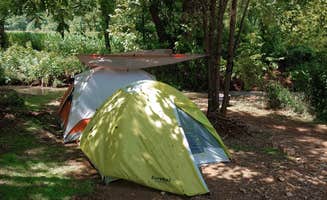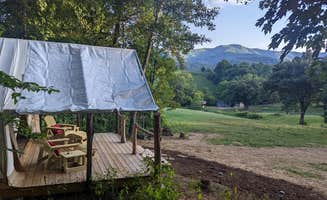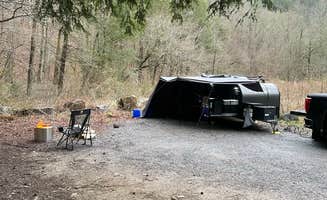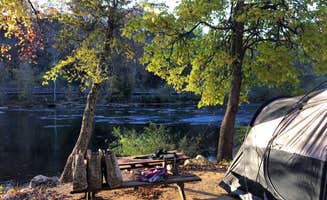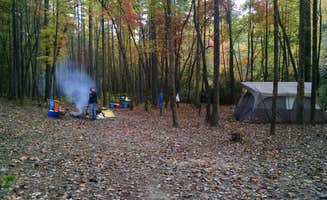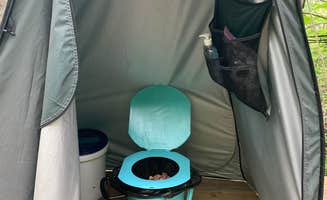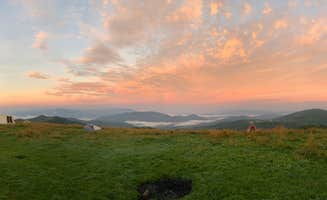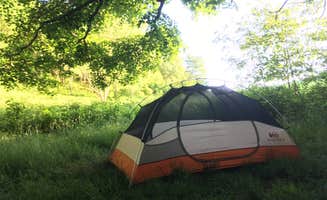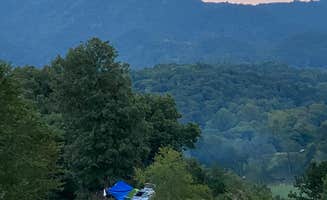Tent camping around Marshall, North Carolina centers primarily on the hilly terrain of the Southern Appalachians, with elevations ranging from 1,700 to 5,000 feet throughout the region. The area receives approximately 45 inches of annual rainfall, creating lush forest environments and numerous water features. Seasonal temperature variations affect camping conditions, with summer highs averaging in the mid-80s and winter lows frequently dropping below freezing.
What to do
Hiking to Max Patch: Access this popular bald mountain summit from Harmon Den Area, located about 30 minutes from Marshall. The 4,600-foot summit offers 360-degree mountain views. "Max Patch is a must see/experience for a sunset/sunrise," notes camper Mickey L.
Soak in mineral springs: Located minutes from Marshall, the historic hot springs provide therapeutic mineral baths. "The hot springs spa is a must hit after a long weekend of hiking and canoeing," reports Alex K. who camped at Hot Springs Campground.
Creek access: Many camping areas feature direct water access for cooling off. "The tents sites along the river were great," notes a camper. Sites along Cold Springs Creek in Pisgah National Forest offer trout fishing opportunities, with regular stocking by wildlife officers.
What campers like
Private riverside sites: Many visitors appreciate the secluded spots near water. "Nice and quite and right by the river. The AT is nearby," mentions Alex K. about camping near Marshall. The sound of flowing water creates natural white noise for sleeping.
Swimming holes: The French Broad and nearby creeks feature natural swimming areas. One visitor at Big Creek Campground reports, "The falls were beautiful, and jumping into Midnight Hole was fun. Even at midnight." These swimming spots provide relief during hot summer months.
Mountain access: The proximity to multiple trail systems attracts hikers. "Walk into town for restaurants and brews! Walk to spa for soak in hot tub!!" notes Roxanne R. about the convenience of certain camping locations. Many sites serve as ideal basepads for day hikes on the Appalachian Trail and other regional paths.
What you should know
Road conditions: Several camping areas require navigating unpaved roads. When visiting Pisgah National Forest dispersed sites, Timothy notes, "I would recommend a 4x4 high clearance vehicle. A short wheelbase van would probably be ok." Forest roads often feature significant ruts and limited width.
Site facilities: Amenities vary drastically between locations. "There are no bathrooms, showers, electricity, running water, trash cans, camp store, firewood for sale, campground hosts, etc. It is pretty much just a space for camping," explains one camper about dispersed sites.
Environmental concerns: Wildlife and plant hazards require attention. "There was lots of poison ivy, so that was another concern I had about my grandson running freely," warns a Harmon Den visitor. Bears are active in the region, requiring proper food storage at all camping locations.
Tips for camping with families
Consider established campgrounds: Facilities make family camping more manageable. "The campground is very small with only 12 campsites. Each one has a firepit, picnic table, lantern pole, and a very large tent pad," reports Katrin M. about Cosby Campground. These amenities reduce the equipment families need to bring.
Look for water features: Creeks provide natural entertainment. "The creek was great for the dogs to cool off. There are also swimming holes nearby," notes one camper. Children can wade, skip stones, and observe wildlife in these protected waterways.
Pack for temperature changes: Despite warm days, mountain nights cool significantly. "Even at midnight" swimming occurs in summer, but spring and fall camping requires warm clothing. Night temperatures can drop 20-30 degrees below daytime highs even in summer months.
Tips from RVers
Limited hookup options: Full-service RV sites are scarce in the immediate Marshall area. "Only 3 fifty amp full hook up sites. Lots of 30 amp and tent camping. Right on the river," explains Sonya A. about Creek Ridge Camping.
Size restrictions: Many forest roads cannot accommodate larger vehicles. "The forest road is not compatible with big rigs, RV's, or travel trailers," warns Timothy about certain areas. Roads frequently narrow to 8-10 feet in width with low-hanging branches.
Seasonal availability: Most campgrounds with RV services operate on limited schedules. "Great campground right on the River town is right across railroad tracks," mentions Henry G. about a site near Hot Springs. Most RV-accessible campgrounds in the region operate from April through October.


